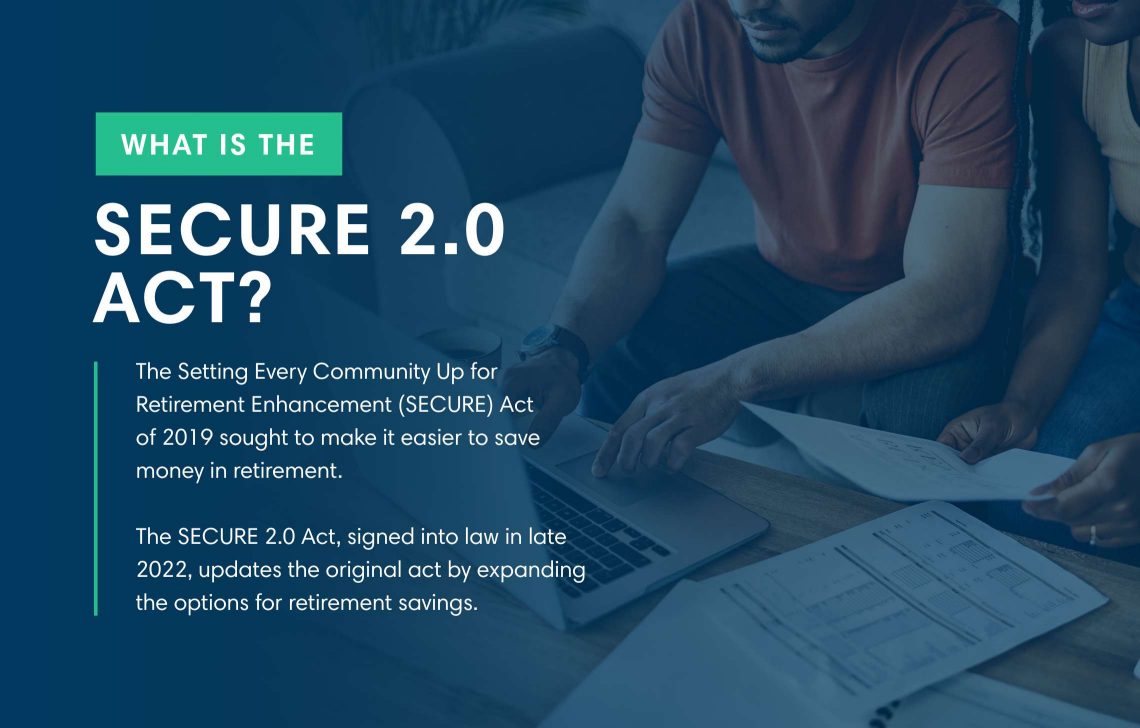How the SECURE 2.0 Act May Reshape Your Retirement Savings
The landmark SECURE 2.0 Act makes changes to retirement account rules that affect broad cross-sections of retirees and retirement savers, from people just entering the workforce to those who are already comfortably retired. Its new rules extend across all income brackets.

"There's something in this law for everybody," says Walt Reed, director of trust and estate tax at First Citizens Wealth Management, an arm of First Citizens Bank.
To help explain the changes and their potential impact on your retirement savings, we've asked Reed and Mike Deming, First Citizens' senior vice president and wealth planning practice leader, to share the practical effects of eight key provisions.
1 Required minimum distributions
A required minimum distribution, or RMD, is the amount set by the federal government that you're required to withdraw each year from certain types of retirement accounts. The intent is to require you to withdraw portions of money from tax-deferred accounts, such as traditional IRAs, so the withdrawals can be taxed as regular income.
For retirees who don't feel that they need to spend the money, RMDs are typically not regarded as a positive because of their tax consequences. SECURE 2.0 raised the RMD starting age to 73 in 2023, then 75 in 2033. It also lowered the penalty for failing to take distributions from 50% to 25%.
Deming: "This might make some people think they're precluded from taking a distribution until age 73, but that's not the case at all. As long as you're over 59 1/2, you can still take them from your retirement plan, but for many people pushing back the age you have to take them is a big gain. If you hold out to the maximum age, your investments will have more time to earn before you have to start paying taxes."
Reed: "Decreasing the penalties for failing to withdraw after your required minimum beginning date from 50% to 25%—with a potential reduction to 10% for IRA holders—helps with keeping all of these changes straight. It allows more leeway for folks who may not exactly have the dates right or are managing multiple plans with different rules."

In broader terms, the SECURE 2.0 Act is an addition to the Setting Every Community Up for Retirement Enhancement, or SECURE, Act of 2019, which sought to make it easier to save money for retirement. The SECURE 2.0 Act, signed into law in late 2022, updates the original act by expanding the options for retirement savings.
2 Catch-up contributions
If you're 50 or older, catch-up contributions allow you to save more in your 401(k) and IRA than the standard annual contribution limits set by the IRS. SECURE 2.0 raises the annual limit for catch-up contributions for those age 60 to 63 from $7,500 to $10,000 for some plans. After 2025, the maximum limit will be indexed to inflation, as will the $1,000 catch-up contribution cap for IRAs for those age 50 and over in 2024.
Deming: "This is a huge help if you're behind in funding your workplace retirement plans, and unfortunately, many people are behind. In conjunction with the increased RMD ages, the jump from $7,500 to $10,000 for annual contribution caps really helps make up for lost time."
Reed: "This change gives you a much better chance of combating inflation post-retirement. With something like the $1,000 cap to IRA contributions being indexed to inflation, it makes it easier to sock more money into a tax-deferred account—increasing your ability to outpace inflation with your investments. When you start taking money out of your IRA, you may be able to push your retirement savings further into your post-work years. For those that take advantage of it, using this change to put more inflation-indexed money into tax-deferred plans will be an important part of building an inflation-beating retirement plan."
3 Employer matching to Roth 401(k) accounts
Under the SECURE 2.0 Act, employer matching contributions to retirement accounts may now be made to Roth 401(k) accounts, meaning the earnings can grow tax-free. Previously, matching contributions had to be made on a pretax basis to traditional accounts.
Deming: "Just having the option of a Roth 401(k) was wonderful, but with these new matching provisions it's an amazing opportunity for extending tax deferral for a very long time. For those 40 years and below, it might seem a bit risky to let go of tax deductions from a regular 401(k) or IRA contribution, but if you just suck it up and use the employer match to fund the Roth 401(k), you're essentially paying yourself. It's a bit more in taxes now, but the benefits you get later are massive. Maybe more so than any other part of SECURE 2.0, for the middle class this provision is a slam dunk."
4 No RMDs for Roth 401(k)s
The arrangement of RMDs for already-taxed contributions to Roth 401(k)s has been removed and replaced with a structure closer to Roth IRAs, which don't require such withdrawals because money taken out of any Roth account is tax-free. The only exception is a Roth IRA inherited from a non-spouse, which must be withdrawn within 10 years.
Deming: "People have been hoping for this going back about 10 years when Roth 401(k)s began to catch on. Requiring RMDs for one type of Roth contribution and not the other was inconsistent. To avoid RMDs, when you had a Roth 401(k) you would need to roll it into a Roth IRA when you left an employer. The problem was that converting to avoid RMDs involved a 60-day period from the check being issued to complete your Roth IRA rollover. If you missed that window, you had some big tax problems on your hands. With these changes, all of that is sorted out. The need to roll over an employer account into a Roth IRA within that narrow window is gone."
5 Employer matching for student loan payments
This change is intended to help employees who may not be able to save for retirement because they're overwhelmed with student debt and thus are missing out on available matching contributions for retirement plans. SECURE 2.0 permits an employer to match an employee's qualified student loan payment with a retirement contribution.
Reed: "If you're coming into the workforce and trying to balance out student debt with getting ahead on retirement funding, the ability for employers to consider making matching contributions to your retirement plan based on your loan payment amount removes some of that tension."
Deming: "From the start, this section of the act was important. But with the Supreme Court having struck down a big part of student loan forgiveness, it's even more so. It won't start until 2024, but the implication for students, especially someone like a small business owner, is significant."
6 Expansions to charitable rollovers
For those 70 1/2 and older, the $100,000 cap on annual distributions to qualified 501(c)(3) charitable organizations has been indexed to meet inflation. Such rollovers are a way for wealthier or simply charitable-minded retirees to roll their RMDs tax-free into a charitable organization rather than pay the regular income tax that would otherwise be due.
Reed: "For years, charitable rollovers were stuck at a $100,000 limit, regardless of what inflation was doing. SECURE 2.0 broke through that ceiling by indexing everything for inflation. What this means practically is that in the future you might be able to funnel some RMDs you have to take into a higher amount of your qualified charitable distribution, allowing you to reduce income on your tax return. With a $100,000 cap, it might seem like this applies primarily to high-net-worth individuals, but that's not the case. If you're middle class and getting RMDs but don't really need them, it's not a choice between contributing the limit or contributing nothing. If your financial team thinks it makes sense for you, you can contribute anything below that cap, like an inflation-adjusted $25,000 or $30,000, and this will reduce the amount of income subject to tax."
7 Automatic enrollment in retirement plans
Starting in 2025, automatic enrollment for retirement plans will be allowed for most major employers. This is seen as a way to boost participation in retirement plans among younger employees, who typically show lower voluntary participation rates than older workers. For example, a US Census Bureau study of retirement account participation found that 49.5% of workers age 24 to 39 owned retirement accounts, compared to 56.1% of employees age 40 to 55 and 58.1% of those age 56 to 64.
Reed: "When you're 24, it's easy to think you don't need life insurance or a retirement plan. But in your 30s with a family, that view shifts a bit. You might feel like you're being dragged in at first, but as a financial professional I cannot overstate the importance of getting a retirement plan and having a 5-, 6-, 7-year head start. This is an important provision, and sooner or later most people will be happy it exists—especially after they've been in the workplace for enough time to realize they don't want to do this forever."
8 Creating a lost-and-found retirement plan retrieval
Through the SECURE 2.0 act, a searchable database will eventually be created to help people find lost retirement plans.
Deming: "SECURE 2.0's provision for locating lost plans is great. People are moving jobs more often, and sometimes plans they've been paying into get lost along the way. If you leave a job and have a 401(k) with a balance of less than, say, $5,000, the employer can pay that out and you can roll that over. But they might not pay it out, especially if the amount in the account is substantial. So life gets busy, you move a couple jobs down the line and you don't remember that at job X you had a qualified plan with a significant amount of money in it. Those are retirement funds just sitting in limbo, and the ability to track them down and claim them will make a big difference.”





